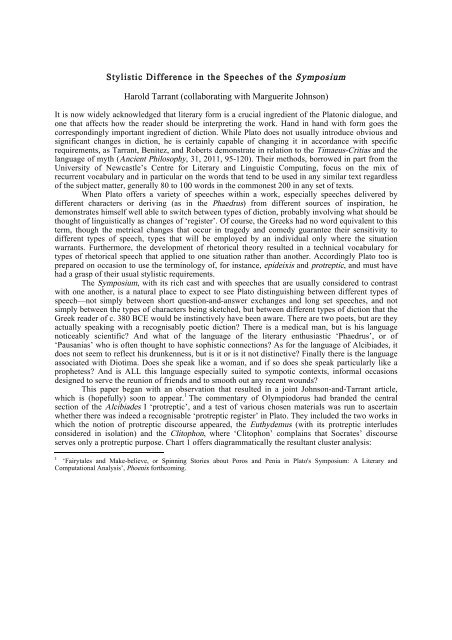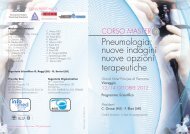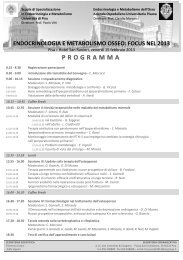- Page 1:
THE INTERNATIONAL PLATO SOCIETY UNI
- Page 5 and 6:
MONDAY, 15 TH JULY, 2013 3 Eros and
- Page 7:
Monday 15 th July, 2013
- Page 11 and 12:
Eros and Life-Values in Plato's Sym
- Page 13 and 14:
Stephen Halliwell proposition that
- Page 15 and 16:
Stephen Halliwell principle of a un
- Page 17:
The Ethics of Eros: Eudaimonism and
- Page 20 and 21:
Yuji Kurihara final clause that sho
- Page 22 and 23: Yuji Kurihara wonderfully beautiful
- Page 24 and 25: ABSTRACT Il ruolo e l'importanza de
- Page 26 and 27: Carolina Araujo if everything is en
- Page 28 and 29: Carolina Araujo changing objects du
- Page 30 and 31: Carolina Araujo Reeve, C. D. C. A s
- Page 32 and 33: David T. Runia transported to the i
- Page 34 and 35: David T. Runia given for why Plato
- Page 37: Method, Knowledge and Identity Chai
- Page 40 and 41: Lesley Brown ἀδελφοῦ ἢ
- Page 42 and 43: Lesley Brown “reconnaître”,
- Page 44 and 45: ABSTRACT The Kind of Knowledge Virt
- Page 46 and 47: Annie Larrivée the Alcibiades, amo
- Page 48 and 49: Annie Larrivée sense that he will
- Page 50 and 51: Annie Larrivée toward a (irrecover
- Page 52 and 53: Annie Larrivée bonheur comme étan
- Page 54 and 55: Annie Larrivée Avant de clore mon
- Page 56 and 57: Annie Larrivée PLATO [1997] The Sy
- Page 58 and 59: Alexis Pinchard dépasser la mesure
- Page 60 and 61: Alexis Pinchard exemple de nature m
- Page 62 and 63: Alexis Pinchard intelligence capabl
- Page 64 and 65: Alexis Pinchard vivant enfante enco
- Page 66 and 67: Alexis Pinchard foncière ; et, tom
- Page 68 and 69: Alexis Pinchard de sa parole vive,
- Page 70 and 71: Alexis Pinchard Donc, quand les mor
- Page 74 and 75: Harold Tarrant 70 Chart 1: Cluster
- Page 76 and 77: Harold Tarrant Neoplatonists would
- Page 78 and 79: Harold Tarrant the arrival of Arist
- Page 80 and 81: Margherita Erbì destinazione. Si t
- Page 82 and 83: Margherita Erbì gli errori evident
- Page 84 and 85: Revisiting the Symposium: the parad
- Page 86 and 87: Ruby Blondell - Sandra Boehringer p
- Page 88 and 89: Un Banquet revisité : l’érotism
- Page 90 and 91: Ruby Blondell - Sandra Boehringer b
- Page 92 and 93: 1. Introduction Symposium 212a6-7:
- Page 94 and 95: Gerard Boter predicate more than an
- Page 96 and 97: Gerard Boter concentrates on the fa
- Page 99 and 100: Immortalità personale senza anima
- Page 101 and 102: Mario Vegetti culmine e il compimen
- Page 103 and 104: Mario Vegetti attingere una forma d
- Page 105 and 106: Mario Vegetti In realtà, anche l'e
- Page 107 and 108: Riferimenti bibliografici Mario Veg
- Page 109: Tuesday 16 th July, 2013
- Page 113: ABSTRACT Wichtige Manuskripte als M
- Page 117 and 118: ABSTRACT A Rejected Version of the
- Page 119 and 120: Lidia Palumbo narratore di tali dis
- Page 121 and 122: Lidia Palumbo di ascoltatori 13 in
- Page 123 and 124:
The Functions of Apollodorus Matthe
- Page 125 and 126:
Matthew D. Walker that “to Meletu
- Page 127 and 128:
Matthew D. Walker contrary, as alre
- Page 129 and 130:
Agatone agathos: l'eco dell'epos ne
- Page 131 and 132:
Dino De Sanctis inferiore, χείρ
- Page 133 and 134:
Dino De Sanctis viaggia con Socrate
- Page 135 and 136:
Giovanni R.F. Ferrari has no need t
- Page 137 and 138:
Giovanni R.F. Ferrari abandons him
- Page 139 and 140:
Anne Gabriel Wersinger (v. 96-97 an
- Page 141 and 142:
Anne Gabriel Wersinger It should be
- Page 143 and 144:
Anne Gabriel Wersinger Philoxenus,
- Page 145:
Phaedrus and Pausanias Chair: Thoma
- Page 148 and 149:
Noburu Notomi or scandalous (but in
- Page 150 and 151:
Noburu Notomi Pausanias then distin
- Page 152 and 153:
Noburu Notomi 663. Notomi, N. (fort
- Page 154 and 155:
Annie Hourcade Sciou l’Hadès pou
- Page 156 and 157:
Annie Hourcade Sciou il l’a fait.
- Page 158 and 159:
Olga Alieva characteristic of the s
- Page 160 and 161:
Olga Alieva difference between the
- Page 162 and 163:
Olga Alieva lover in Pausanias is s
- Page 164 and 165:
Olga Alieva were published. 65 The
- Page 166 and 167:
Lucia Palpacelli Questa è la prima
- Page 168 and 169:
Lucia Palpacelli stessa incoraggi s
- Page 170 and 171:
Lucia Palpacelli di pensare all’e
- Page 172 and 173:
Lucia Palpacelli Reale G., Per una
- Page 174 and 175:
Jens Kristian Larsen from his speec
- Page 176 and 177:
Jens Kristian Larsen depends on a p
- Page 178 and 179:
La pédérastie selon Pausanias : u
- Page 180 and 181:
Olivier Renaut Le programme est don
- Page 182 and 183:
Olivier Renaut discours de Diotime,
- Page 184 and 185:
Olivier Renaut Nussbaum, M. C. 1994
- Page 187 and 188:
Eryximachus’ Medicine in the Symp
- Page 189 and 190:
Hua-kuei Ho example of τέχνη b
- Page 191 and 192:
Hua-kuei Ho Jones, W. H. S., ed., H
- Page 193 and 194:
Silvio Marino Se all’interno del
- Page 195 and 196:
Silvio Marino Il fatto è che anche
- Page 197 and 198:
ABSTRACT Eryximachus’ Physical Th
- Page 199 and 200:
Laura Candiotto observation of natu
- Page 201 and 202:
Laura Candiotto between similar ele
- Page 203 and 204:
Conclusion: the philosophical impor
- Page 205 and 206:
Sophrosyne in the Symposium Richard
- Page 207 and 208:
Richard Stalley will obey (441e-442
- Page 209:
ABSTRACT El dilema “Erixímaco”
- Page 213 and 214:
Le Banquet de Platon : une philosop
- Page 215 and 216:
Michel Fattal intéressante à cet
- Page 217 and 218:
Michel Fattal (tinos) qu’on ne po
- Page 219 and 220:
Michel Fattal entre des domaines s
- Page 221 and 222:
Michel Fattal d’opinion » 29 . A
- Page 223 and 224:
Michel Fattal le corps et l’âme,
- Page 225 and 226:
Arianna Fermani sembrò loro essere
- Page 227 and 228:
Arianna Fermani che supera i confin
- Page 229 and 230:
Arianna Fermani morte, ma ne fa la
- Page 231 and 232:
Cristina Rossitto οἴει, ὅτ
- Page 233 and 234:
Cristina Rossitto κακόν ἐσ
- Page 235 and 236:
Cristina Rossitto "Dimmi: non affer
- Page 237 and 238:
Cristina Rossitto stretto come comp
- Page 239 and 240:
Thomas M. Tuozzo Socrates’ reanal
- Page 241 and 242:
Thomas M. Tuozzo as the lover pregn
- Page 243 and 244:
Gli eroi e la natura demonica di Am
- Page 245 and 246:
Piera De Piano diverse lingue degli
- Page 247 and 248:
Piera De Piano e generano divisione
- Page 249 and 250:
Piera De Piano Narcy 1981 = M. Narc
- Page 251:
Agathon Chair: Debra Nails
- Page 254 and 255:
Francisco J. Gonzalez pretty words
- Page 256 and 257:
Francisco J. Gonzalez he does so in
- Page 258 and 259:
Francisco J. Gonzalez prevailing vi
- Page 260 and 261:
Francisco J. Gonzalez If we are tem
- Page 262 and 263:
La mimesis di sé nel discorso di A
- Page 264 and 265:
Mario Regali νέος da Socrate, p
- Page 266 and 267:
Mario Regali Platone: il dialogo, u
- Page 268 and 269:
Irmgard Männlein-Robert und Agatho
- Page 270 and 271:
Irmgard Männlein-Robert demonstrie
- Page 272 and 273:
Introduction EROS SOTER: How Can Lo
- Page 274 and 275:
Aikaterini Lefka who replace the he
- Page 276 and 277:
Aikaterini Lefka Selective Bibliogr
- Page 278 and 279:
Aikaterini Lefka K. Kérenyi, Die J
- Page 280 and 281:
ABSTRACT Agathon’s Gorgianic Logi
- Page 282 and 283:
Nicholas Riegel dialogue’s struct
- Page 284 and 285:
Nicholas Riegel problem death poses
- Page 286 and 287:
Nicholas Riegel the main problems a
- Page 289 and 290:
ABSTRACT Platonic Fables as Philoso
- Page 291 and 292:
Aristofane e Platone. Sulla “Natu
- Page 293 and 294:
Diotima, o dell’Uno come Bene. Cl
- Page 295 and 296:
Claudia Luchetti dialoghi platonici
- Page 297 and 298:
Claudia Luchetti H.G. Gadamer, Wahr
- Page 299 and 300:
Claudia Luchetti that, with this la
- Page 301 and 302:
Claudia Luchetti καὶ λέγετ
- Page 303 and 304:
Claudia Luchetti the first, is that
- Page 305 and 306:
Claudia Luchetti W. Beierwaltes, Lu
- Page 307 and 308:
ABSTRACT The Comic and the Tragic:
- Page 309 and 310:
Michele Corradi esposizione tipiche
- Page 311 and 312:
Michele Corradi allo sviluppo della
- Page 313 and 314:
What Socrates learned from Aristoph
- Page 315 and 316:
Samuel Scolnicov the temporal expre
- Page 317 and 318:
Split Personalities in the Symposiu
- Page 319 and 320:
Roslyn Weiss 2 in Genesis thus ends
- Page 321:
Wednesday 17 th July, 2013
- Page 325 and 326:
Sokrates’ Rollen im Symposion: se
- Page 327 and 328:
Thomas Alexander Slezák Priesterin
- Page 329 and 330:
Thomas Alexander Slezák anamnesis,
- Page 331:
Giuseppe Cambiano shortness are uni
- Page 335 and 336:
1. Introducción Symposion 210d4:
- Page 337 and 338:
Francisco L. Lisi los sentidos. No
- Page 339 and 340:
Francisco L. Lisi Strauss, L. (2001
- Page 341 and 342:
commence par l'amour d'un seul corp
- Page 343 and 344:
Arnaud Macé synthèse du corporel
- Page 345 and 346:
Arnaud Macé τινὰ τοιοῦ
- Page 347 and 348:
Arnaud Macé genres, on ne peut pro
- Page 349:
ABSTRACT L’interpretazione plotin
- Page 353 and 354:
I: INTRODUCTION On the Early Speech
- Page 355 and 356:
Philip Krinks activity is in itself
- Page 357 and 358:
Philip Krinks By using the particip
- Page 359 and 360:
Boasting and self-promotion in Plat
- Page 361 and 362:
Gabriel Danzig (185) Following Bury
- Page 363 and 364:
Gabriel Danzig Pausanias As a devot
- Page 365 and 366:
Gabriel Danzig about the possibilit
- Page 367 and 368:
Gabriel Danzig character, mentality
- Page 369 and 370:
I. La difficile analogia tra poesia
- Page 371 and 372:
Giovanni Casertano che si divide in
- Page 373 and 374:
Giovanni Casertano amore del bello,
- Page 375:
Onoma e holon in Symp. 204e-206a: c
- Page 379 and 380:
Alcibiades’ Refutation of Socrate
- Page 381 and 382:
II Edward C. Halper With this under
- Page 383 and 384:
Edward C. Halper argument or, as we
- Page 385 and 386:
Edward C. Halper Scott, Gary Alan,
- Page 387 and 388:
Sócrates aprendiz y maestro de Ero
- Page 389 and 390:
Graciela E. Marcos de Pinotti inten
- Page 391 and 392:
Graciela E. Marcos de Pinotti Y bie
- Page 393 and 394:
Platone, la virtù e un gioco di sp
- Page 395 and 396:
Federico M. Petrucci sembra fondato
- Page 397:
Federico M. Petrucci virtuoso, del




